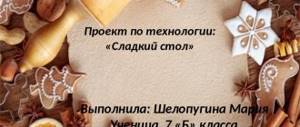The history of gingerbread
The history of gingerbread goes back centuries.
Its emergence is inextricably linked with such a great discovery of mankind as bread, which appeared back in the 5th century. BC. For the first time in history, honey cakes are known as Lebkuchen (today German Christmas gingerbread), which were originally invented in Belgium in the city of Dinant.
The first gingerbread in Russia was called “honey bread” and appeared around the 9th century; they were a mixture of rye flour with honey and berry juice, and the honey in them made up almost half of all other ingredients.
Later, forest herbs and roots began to be added to “honey bread,” and in the 12th-13th centuries, when exotic spices brought from India and the Middle East began to appear in Rus', gingerbread received its name and almost finally took shape into the delicacy that is known us. Lemon, mint, vanilla, ginger, cumin and cloves were added to gingerbread cookies.
By the 18th-19th centuries, gingerbread production already flourished in Perm, Arkhangelsk (Arkhangelsk gingerbread - rozul), Kursk, Kharkov, Ryazan, Kaluga, Tver, Vyazma (Vyazma gingerbread), Tula (Tula gingerbread), Novgorod, Gorodets (Gorodets gingerbread). Tver gingerbread makers had shops in Berlin, Paris and London.
Research work on the topic “Gingerbread - a symbol of the holiday”
https://infourok.ru/issledovatelskaya-rabota-pryanik-simvol-prazdnika-3948324.html
Research work on the topic “Gingerbread - a symbol of the holiday”
Logacheva Daria Vasilievna
Scientific supervisor: Sorokina S.V.
In this work, the author introduces the history of the emergence of such a beloved delicacy - gingerbread, with folk customs and traditions associated with gingerbread, describes the technology for making festive gingerbread, and proves that gingerbread is not only a favorite treat, but also a wonderful inexpensive gift for any holiday.
Introduction
On January 25, I celebrated my birthday with my classmates at the Confiture confectionery. In addition to competitions and congratulations, the holiday program included hand-made cooking of various culinary products: pizza, cookies, cakes and gingerbread. My guests and I liked this part of the program the most, because at home our parents don’t often involve us in preparing any dishes, but in the pastry shop we felt like real chefs. I wanted to continue to show my creativity in the culinary field.
I decided to start making gingerbread cookies. Why gingerbread? The answer is simple: during the Christmas holidays I tasted unusual gingerbread cookies, holiday gingerbread cookies made in the shape of a house, Christmas trees and various New Year's characters. These gingerbreads were very different in taste from traditional store-bought gingerbreads. I decided to find out what the secret is to making such gingerbread cookies and whether I could make such gingerbread cookies myself at home.
Object of study
is the technology for making holiday gingerbreads.
The subject of the study
is the ancient folk delicacy gingerbread.
Research methods:
Theoretical – searching and studying information.
Practical – survey, questioning, gingerbread making.
Purpose:
make holiday gingerbread cookies as gifts for your friends, relatives and acquaintances
To achieve the goal, the following tasks
1. Study the literature and find out the history of the origin of gingerbread.
2.Find out what types of gingerbread cookies there are.
3.Learn gingerbread recipes.
4. Master the technology of making holiday gingerbread cookies.
5. Calculate the cost of the holiday gingerbread.
History of gingerbread: in Russia and abroad.
Gingerbread is a flour confectionery product baked from special dough; For taste, honey, nuts, raisins, fruit or berry jam can be added. The gingerbread looks like a shaped, rectangular or oval plate with a pattern embossed on the top of it.
Gingerbread has come a very long way since its inception. Its emergence is inextricably linked with such a great discovery of mankind as bread. Having cultivated wild plants and tamed wild animals, people acquired a House. And since people learned to bake unleavened cakes from grain porridge, bread became for them not only their daily food, but also the basis of life, culture, religion, and relationships with other peoples.
In ancient Iran, where they worshiped the sun god Mithras, in his honor the flatbread was given a round shape, which is still preserved among the peoples of the Middle East and Central Asia (the Slavic pancake also symbolizes the Sun). Two thousand years ago in Syria, treaties were sealed by shaking hands over bread, and the Egyptians offered bread as a pledge of peace.
There were a great many rituals and cults associated with bread, but they all had one thing in common - the desire to receive the protection of the gods. The transition from ritual cookies to gingerbread took place over several centuries.
However, it is known that the ancient Romans and Egyptians loved to indulge in such delicacies - honey cakes seasoned with spices were first mentioned in written sources in 350 BC! And already in our era, the Belgians were the first to bake gingerbread in the city of Dinan - today their recipes have been transformed into the Lebkuchen Christmas gingerbread cookies, which are baked in Germany. In Rus', the technology for preparing this delicacy has become a little different. Initially, gingerbread was baked with a large amount of honey - up to 50% of the total weight of all ingredients, and they were called “honey bread”. Only from the 12th-13th centuries, when Indian and oriental spices appeared on sale and were widely added to these products, they began to be called “gingerbreads”. Most often in Rus', gingerbread was prepared with bitter orange peel, lemon, vanilla, mint, nutmeg, cumin, anise, ginger and even black pepper and Italian dill!
A significant event in the development of the gingerbread business was the discovery of sugar in beets by the Margrave in 1747, which revolutionized the entire confectionery industry. Gingerbread production has grown to enormous volumes, but the complete elimination of honey has reduced the taste of gingerbread, since its enzymes give the product a unique aroma and freshness. “Dry perfumes” play an important role in creating the taste and aroma in gingerbread: ginger, cardamom, cinnamon, cloves, allspice, apis, cumin, coriander, nutmeg, star anise, saffron, thyme, mint, vanilla - these are the spicy aromatics plants used to create a bouquet. Their therapeutic and preventive effects on the human body are known.
In the 17th-19th centuries, gingerbread making was a widespread folk craft. Each locality baked its own gingerbread according to traditional recipes, and the secrets of making were passed down from generation to generation. The craftsmen who were engaged in gingerbread production were called pryanishniks (hence the famous surname Pryanishnikov).
Many Russian provinces could boast of their printed gingerbreads, and a surviving document from the 18th century notes the special charm of Vyazma gingerbreads: “Many of the merchants and philistines make the so-called Vyazma gingerbreads, which are known and famous throughout Rus'.” By the end of the 19th century, gingerbread shops in Russia offered about twenty varieties of gingerbread.
The production of gingerbread is a rather complex and labor-intensive technological process. This is how N.N. described it. Lyashko in his autobiographical novel “Sweet Hard Labor”: “There was a roar in the gingerbread workshop, and there was a thick smell of ammonium and mint oil. About fifteen gingerbread makers pressed lumps of dough into the nest of wooden stamps with their palms, hit the stamps on the workbench, and the raw molded gingerbread cookies flew onto the panel. The workers collected them from the cloth and put them on trays... Rows of boys and girls rolled out mint dough on a workbench along the windows and, imperceptibly to the eye, with long knives - tra-ta-ta-ta - cut it into even pieces. The workers rolled these pieces in flour, turned them into balls with their palms and threw them onto the table in the middle of the workshop using a kind of scoop. Here about thirty men, boys and women squeezed these balls into wooden molds, hit them, and raw gingerbread with the letters “KhPV” (Khariton Petrovich Voskoboynikov - merchant, owner of the factory) fell into the middle of the table.”
Thus, we see that the production of gingerbread was a labor-intensive, complex technological process.
The flavor diversity of Russian gingerbread depended on the flour (as a rule, they used sieve rye or coarse wheat) and on the dough (simple unleavened was used to make cheap varieties, sour ones were used to make expensive “gingerbreads”, there was also choux pastry and dough kept in the cold), from the base on which the dough was kneaded (with honey - the so-called “one-copper”, on molasses, on malt, on wort, on sugar syrup, on rose water, on berries), and, of course, on spices and additives called in the old days “dry perfumes”, among which the most popular were black pepper, Italian dill, orange peel (bitter orange), lemon, mint, vanilla, ginger, anise, cumin, nutmeg, cloves.
Types of gingerbread.
In Russia there were three types of gingerbread, which got their name from the technology of their production: molded, cut out and printed.
Of particular importance were the northern “roes” baked in the Murmansk, Arkhangelsk, Vologda, Olonets provinces, and on the White Sea coast. No special equipment was required for molding them - they were sculpted from dough directly by hand. The beauty and expressiveness of such gingerbreads depended entirely on the skill of the nekar, on his ability to convey the most characteristic things in a conventional decorative manner. Modeled gingerbread cookies were sometimes a rather complex decorative sculpture, the production of which required a lot of labor. They were once associated with the pagan rituals of ancient Rus'.
Printed - the most common, was made using a gingerbread board made of hardwood, usually linden. Initially, the images on gingerbread boards reflected popular biblical and mythological scenes: Madonna and Child, Adam and Eve, Samson with a lion, playing Orpheus. Printing forms for the production of gingerbread remained in use until the end of the 19th century, and then this labor-intensive production gave way to the production of figured-cut gingerbread.
Cut-out gingerbread cookies were cut from dough with a knife or a metal mold in the form of a strip curved along the contours of the gingerbread. By pressing it into the dough, identical silhouette figures were obtained.
There were also gingerbreads, which modern researchers call combined. They combined a flat silhouette made of dark dough and a figurine made of colored sugar sculpted on it. Such gingerbread cookies, usually baked in Kolomna and Kaluga, were small in size and intended to decorate the New Year tree.
Gingerbread: tradition and modernity
The name “gingerbread” appeared because the product contains a large amount of spices. In addition, gingerbread differs from other flour products in its high sugar content. A variety of shortcakes and gingerbreads are also made from gingerbread dough. According to the manufacturing method, gingerbread is divided into two types - custard and raw. The rest of their many varieties depend on the glaze, the presence of filling, that is, the baker’s imagination.
Gingerbread is a symbol of the holiday, although gingerbread was made not only for holidays.
Many folk customs and traditions were associated with gingerbread. Gingerbread cookies were divided according to their purpose: gifts, farewells, weddings, funerals, medicinal, games... Not a single event took place without them. Thus, gingerbread was given to the bride at a wedding, and the wedding feast ended with the guests being given a piece of gingerbread.
Having received a piece, the guests knew that the holiday was over and it was time to go home, so this gingerbread was called “dispersal”. Girls who dreamed of marriage then ate this gingerbread with a special feeling. And the gingerbread itself was made large and beautifully decorated. The next day after the wedding, the newlyweds went to their parents’ house with gingerbread, and everyone put gifts and money on it.
There was another custom: catching gingerbread. On the second day of Easter, girls in their best outfits lined up in a circle on the site near the church, and the guys threw gingerbread cookies, bagels, and candies at them, and everyone tried to hit their chosen one.
On Yegoryev's Day (April 23), molded, figured gingerbread was given to animals so that the cattle would go home on their own in the summer and breed better.
For the New Year, small gingerbread cookies were baked in the shape of birds and animals, which were used as Christmas tree decorations and at the same time served as a delicacy. During Christmas time, the most valuable gift for carolers was gingerbread - as a symbol of well-being, prosperity, and wealth.
For the New Year and Christmas, children baked special gingerbread figurines in the form of churches, young ladies, gentlemen, animals, trees, fairy-tale characters, and so on. Gingerbread cookies for children, made in the shape of capital letters, also served them as a kind of sweet alphabet. The custom of giving each other gingerbread for Christmas was born in Western Europe and came to Russia in the 18th century. .
It was customary to give gingerbread cookies on Forgiveness Sunday, which fell on the last day of Maslenitsa before the start of Lent. On this day, according to Christian custom, they went to “say goodbye” - to ask each other for forgiveness for all the offenses caused. The visits were accompanied by offerings of pies and very large gingerbread cookies (from two to five kilograms).
Gingerbread was credited with medicinal properties. It was believed, for example, that gingerbread, specially made in monastery bakeries, had healing properties and helped in the treatment of some serious illnesses. Therefore, the monastery servants baked them with special diligence, decorating the reverse side with capital letters of the names of the archangels.
Small gingerbread cookies were also used for games. Most often, such public games were organized during fairs and bazaars, where those wishing to demonstrate their skills gathered and competed in throwing gingerbread at a distance. The player whose gingerbread flew the farthest and did not break when falling to the ground was considered the winner and received it as a prize.
At all times in Rus', gingerbread cookies have enjoyed special love and respect. They were prepared for celebrations, given as gifts, as a sign of love and respect. Today, gingerbread cookies are no longer as popular as they were 100 years ago, but, meanwhile, their preparation is quite simple. But how can you surprise everyone with such a wonderful dessert!
Practical part
Before I started making gingerbread, I found several recipes for making holiday gingerbread on the Internet. From several recipes I chose one:
Dough
2 cups of milk, 1 tablespoon of butter, 4 cups of sugar (bring to a boil, scald 5 cups of flour with this mixture): everything cools down, add 1 cup of sour cream, 4 yolks, 3 teaspoons of soda (stir, knead the dough) it should sit 0 ,5 hours.
Add more flour.
Glaze. 4 egg whites, 3 cups sugar, 10 tablespoons of cold water (cook in a water bath until the sides begin to dry out.) If you have good homemade butter, you can replace the sour cream with good homemade yogurt.
The gingerbread and frosting should be cold when mixing.
I’ll tell you a little secret to the home cook for making homemade gingerbread:
— The word “gingerbread” comes from the word “spices,” the presence of which in these products is their characteristic feature.
— Gingerbread wrapped in foil or film retains its taste for a long time and does not become stale. Gingerbread products include gingerbread cookies and gingerbread cookies. Currently, gingerbread cookies can be prepared either with sugar alone or with a mixture of it and honey. After all, when heated, honey still loses its special properties - only sweetness and taste remain.
— Depending on the sugar and honey content, the main gingerbread dough has three varieties: honey, sugar (without honey) and honey-sugar.
-The dough can be prepared in two ways: raw and choux. Gingerbread products made from raw dough are easier to prepare, but quickly dry out and become hard. Gingerbread cookies made from choux pastry are tastier and remain soft and aromatic for a long time.
— Hard gingerbread dough can be baked on a clean baking sheet without grease, and soft dough can be placed on a greased baking sheet. Before baking, brush the gingerbread with egg yolk. -Bake small and thin gingerbreads at a temperature of 220-240°C for 8-15 minutes, and large products and gingerbreads at a temperature of 180-220°C. Immediately after baking, wipe the surface of the gingerbread with a soft cloth. This increases the shine of the products.
Conclusion
Today, gingerbread can hardly be called the most popular dessert, and the reason for this trend is that store-bought gingerbreads have long been different from those eaten in Russia before the 20th century, and not every housewife decides to make homemade ones. Once you make gingerbread at home, which is not as difficult to do as it might seem at first glance, you will definitely look at this delicacy in a new way.
There is no such variety of gingerbread as in Russia in any other country in the world. There are even gingerbread museums with exhibits that are about 300 years old. And they even retained their original appearance and honey aroma. But it’s not recommended to eat such gingerbread, not only because of its historical value, but also because of its hard content. The gingerbreads simply dried up there.
Our ancestors were very fond of gingerbread - they were baked for the holidays, given to each other as a sign of love and respect, and on especially special occasions they were made very beautiful, of unusual shape, with various designs and inscriptions. Tula, Vologda, Tver, Moscow and Arkhangelsk became famous as the “gingerbread capitals”, and Tula gingerbreads are still popular in our country today – where the art of their preparation has been passed down from generation to generation for many centuries in a row.
Thus, we can conclude that gingerbread is one of the most famous domestic confectionery products. The popularity of this delicacy, both in Russia and abroad, is explained by a tradition that dates back to ancient times. In addition to taste, gingerbread also has a certain aesthetic value. In particular, foreign tourists often purchase them as souvenirs. That is, in addition to the consumption of this product on the domestic market, it also has export potential, which makes the idea of opening gingerbread production interesting.
However, at modern holiday feasts you don’t often see these wonderful products - gingerbread. But they are not so difficult to prepare and do not require much time. By making gingerbread with your own hands, you will pleasantly surprise your guests with the opportunity to try the famous national dish.
Making delicious gingerbread is a very creative process, depending on what spices you add, the taste and aroma of gingerbread can change greatly; it’s not for nothing that recipes in gingerbread families have been passed down from generation to generation. Once you make delicious homemade gingerbread, you will love them forever!
Bibliography
Dal V.I. Explanatory dictionary of the Great Russian language. Electronic edition. 2. Konovalova M. Study of gingerbread // Bread products. No. 3. 2004. 3. Lupina O. From the history of gingerbread making // Around the world. No. 2. 2002. 4. Internet resources:
https://supercook.ru/
https://1000.menu/catalog/pryaniki
New Year's gingerbread ideas
After studying the history of gingerbread, I came up with several options for the finished product:
Option No. 1 “Gingerbread House”
Very beautiful gingerbread, I’ll try to make it.
Option No. 2 “Christmas tree toy”
This idea suits me; here you can make any fantasy come true.
Option No. 3 “Tula gingerbread”
A beautiful gingerbread, but it is printed, i.e.
For production, special wooden molds are needed. I don’t have this form, so this option doesn’t suit me. Option number 4 “Horseshoe for luck”
A very delicate, openwork pattern, but I think I don’t have enough experience. I'll leave this idea for the future.
Option No. 5 “Gingerbread souvenir”
Original idea, I think I can do something similar.
Analysis of the idea, selection of the best version of the holiday gingerbread. Having examined all the options I liked, I settled on options No. 2 and No. 5. Of course, this is a very labor-intensive work that requires accuracy and attentiveness, but such a gift will definitely not leave anyone indifferent. My parents and friends, having read my idea, approved of my choice.
New Year's gingerbread recipe
During the research, it turned out that there are a huge variety of recipes for Russian gingerbread. The difference was not only in composition, but also in shelf life. In our country, it is customary for the New Year tree to be decorated until January 14 (Old Style New Year), which means that gingerbread cookies must remain fresh for a long time, so I decided to choose a recipe according to which cooked gingerbread cookies can be stored for up to a year.
Recipe "Arkhangelsk gingerbread"
Ingredients:
| № | Ingredient | Quantity |
| Dough | ||
| 1. | Sugar | 600 g |
| 2. | Water | 200 ml |
| 3. | Butter (margarine) | 200 g |
| 4. | Spices: | |
| Cinnamon | 2 parts | |
| Carnation | 1 part | |
| Ginger | 1 part | |
| Cardamom | 1 part | |
| Nutmeg | 1 part | |
| 5. | Soda | 2 tsp. |
| 6. | Egg yolk | 4 things. |
| 7. | Salt | 0.5 tsp |
| 8. | Flour | 1 kg |
| Glaze | ||
| 9. | Egg white | 2 pcs. |
| 10. | Sugar | 200 g |
Tools and equipment for making gingerbread
To make and paint gingerbread cookies, I needed a large number of tools and utensils.
Dishes:
A frying pan with high sides. A cup for beating eggs. A baking sheet. Teaspoon Tablespoon Silicone spatula (for stirring)
Devices:
- Electric kettle.
- Blender.
- Electric oven.
- Baking molds.
Safety precautions when preparing gingerbread
When performing any work, safety regulations must be strictly observed. Since I will be cooking, I need to follow the following rules:
- Hair should be tucked under a headscarf.
- Regardless of how careful the cook is, it is necessary to use an apron.
- All work must be done with cleanly washed hands.
- There should be no objects that are not related to the preparation of the dish in the workplace.
- Kitchen utensils used must be clean.
- Products must be fresh. Be sure to check the expiration date.
- When using sharp objects, you must be extremely careful.
- When working with an electric stove, you must stand on a rubber mat.
- Wash the stove after it has cooled completely and with the power off.
- To avoid getting burned, you must use oven mitts.
- When making the dough, be careful when pouring boiling water into the burnt sugar.
Technology for making New Year's gingerbread cookies
I carried out the work using the following technology:
- In a deep frying pan, I burned 300 g of granulated sugar until dark brown, stirring constantly.
- I quickly and carefully poured 200 ml of boiling water into the frying pan.
- I poured another 100 g of granulated sugar and stirred.
- Added another 200g of butter and continued stirring until it completely melted. Removed the pan from the heat and let it cool completely.
- I prepared the spices: 2 parts cinnamon, 1 part cloves, 1 part ginger, 1 part cardamom, 1 part nutmeg. Spices give roe deer a special taste and also ensure a long shelf life - up to a year.
- The remaining mixture of ghee and burnt sugar was poured into a deep bowl.
- Beat 2 eggs and 4 egg yolks until smooth.
- Pour the beaten eggs into the bowl with the butter and sugar. I poured the prepared spice mixture into it. Added 0.5 tablespoons of salt. Mixed everything thoroughly.
- All that's left is to add flour! I kneaded the dough, gradually pouring flour into it.
- Kneaded the dough.
- When the dough stopped sticking to the sides of the bowl, I put it on the table sprinkled with flour. The dough has become soft and elastic.
- I wrapped the dough in a bag and put it in the refrigerator for a day.
- I sprinkled flour on the table and prepared the baking tins.
- I took the dough out of the refrigerator, cut off a small piece and rolled out a layer 4-5 mm thick.
- Now I took the molds and cut out the figures.
- Lined a baking sheet with parchment paper and laid out the figures. Placed in the oven for 5-7 minutes, at a temperature of 180-200º
- The roes are ready!
The next step is preparing the glaze.
- I separated the whites from the yolks.
- I poured 200g of sugar and 200ml of water into a small saucepan and put it on medium heat.
- At the same time as preparing the sugar, I beat the egg whites.
- When the sugar thickened to a “soft ball,” I gradually poured it into the egg whites, whisking continuously.
- The glaze is ready!
- After preparing the dough and glaze, I painted the gingerbread cookies.
Economic rationale for making gingerbread
| Name | Quantity | Price |
| Sugar | 800 g | 20 rub./pack (1 kg)2 |
| Butter | 200 g | 38 rub. |
| Cinnamon | 10 g | 10 rub./pack |
| Carnation | 10 g | 10 rub./pack |
| Ginger | 10 g | 12 RUR/pack |
| Cardamom | 10 g | 10 rub./pack |
| Nutmeg | 10 g | 14 RUR/pack |
| Egg | 6 pcs | 48 rub./dozen |
| Salt | 0.5 tsp | — |
| Flour | 1 kg | 26 RUR/pack (1 kg) |
| Soda | 2 tsp | 20 rub./pack |
| Total: 208 rub. | ||
So, a batch of gingerbreads, consisting of 3 (20x20cm) large and 25 (8x8cm) small gingerbreads, cost me only 208 rubles. On average, small gingerbread cookies (Fig. 12) cost from 100 rubles/piece. I have 25 of these, i.e. 25×100=2500 rub. Large gingerbread cookies (Fig. 13) cost from 300 rubles. those. 300×3=900 rub. Total: 2500+900=3400 rub.
Conclusion: Baking gingerbread cookies yourself is much more profitable.
Evaluation of prepared gingerbread
Having made the first batch of gingerbread cookies, I gave the finished product to my parents and friends to try, everyone really liked it and they wouldn’t mind receiving such a gift for New Year or Christmas. I believe that the goal has been achieved.
Now all I have to do is make the required number of gingerbread cookies, making one part as Christmas tree decorations and the other as a souvenir.
Ecological rationale for preparing gingerbread
Gingerbread cookies are made from natural fresh products and are a healthy treat that is not harmful to health.
Production waste includes eggshells, paper wrappers from flour and butter. These objects are not toxic and do not harm the environment.
Useful tips for making New Year's gingerbread cookies
To make the glaze shiny and not too cloying, you can add lemon juice.
Use food coloring to make icing to make your gingerbread cookies colorful.
If you don’t have a pastry syringe, you can use a medical syringe, a plastic bag or a bag of parchment paper.
Advertising New Year's gingerbread
New Year is approaching, but you have a lot of friends and little money for an original gift? Make a New Year's toy with your own hands! Plunge into old Russian traditions!







